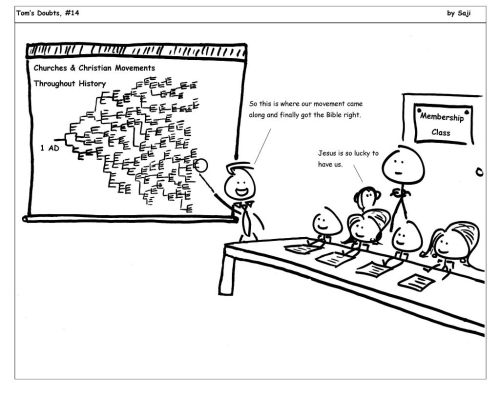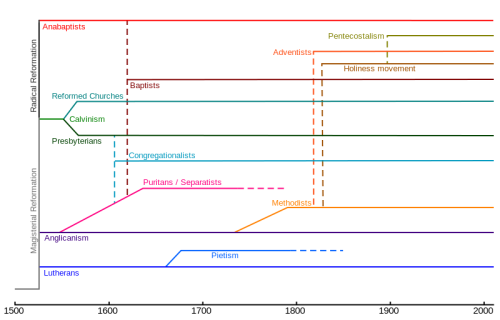History of Heresy

Used Without Permission From: https://twitter.com/S_A_J_I/status/110040087445782528/photo/1/large
I ran into the above visiting Patheos today, and thought a meta-heresy post would be useful and clear up a major misconception in the comic.
The first point would be that in the year 1,000, there was only one Christian Church (excepting some Nestorians and Monophysites, who rejected a few ecumenical councils but of whom large parts returned to communion with Rome after 1,000 AD). There was an East-West argument brewing, but they were still united. Nearly all the heresies from early on had died out. New ones continually being invented but subsequently dying out as well. So half the chart in the comic should be just a strait line (or at most three lines that show some merging in the other half) with short little offshoots.
Now, for a variety of complex factors around 1050 the Church split into Orthodox and Catholic. They are quite similar, differing in only a few points of theology. In fact, the difference is so little Catholics might even receive communion at Orthodox Churches (if the Orthodox priest allows it) and vice versa. The differences between Russian Orthodox and, say, Greek Orthodox is similar to the difference between the Diocese of Santa Fe and the Diocese of New York — which is to say those differences aren’t theological but managerial. Catholics focused on the universal (aka catholic) aspect of the Church and Papal authority, while the Orthodoxy focused on what they thought was true (aka orthodox), and that was the root of the split.
For another 500 years or so small little heresies grew, burst, and healed like acne across the face of Christendom. In the 1500’s Luther, Calvin, Zwingli and Henry VIII all created their own churches. This was the start of Protestantism, which wouldn’t heal like the previous heresies. In addition, they often drew on the carcasses of long dead heresies. For instance, the Albigensians (around the 1100’s and 1200’s) had a baptism of the Spirit called “consolamentum”, not that unlike a modern “altar call”. Yet the modern Protestants who use altar calls reject the high praise of suicide that Albigensians also had. My posts tend to look at these singular aspects of a heresy popping up again in the news, while knowing full well no one holds to all the tenants of the dead heresy.
Later, some of these Protestant groups which formed in the 1500’s split again. For instance, the English King Henry VIII started Anglicanism so he could divorce and remarry as well redistribute the vast amount of land the Church was endowed with. Many Christians in the American Colonies were Anglican because they came from England. After the Revolutionary War, they didn’t want to hold spiritual allegiance to a king they just threw off the political yoke of, so they invented Episcopalianism and had the Bishops (Episcopals) lead the church. Other divisions, like the difference between high and low Lutherans, have more to do with theology and worship style (which often go hand in hand). These denominational divisions are a result of an absence of Church authority that had existed for 1,500 years. In those short 500 years all the division and splitting into countless churches that the comic depicts has occurred.

Used Without Permission From: http://en.wikipedia.org/wiki/File:Protestant_branches.svg
Amidst all this splintering, Catholics still remain the largest group. In fact, Catholics are so far in the lead that in America lapsed Catholics turn out to be the third largest Christian group. The volume of adherents isn’t shown in the comic, and instead tiny little splinter groups are given equal weight with much larger groups.
Ideally, then, the chart in the comic should have at most four lines running into the last quarter of it, not all these splits from what is marked as 1 AD. All the little splits shown in the comic are really just from Protestantism after the year 1,500. If this multiplied division of churches is problematic, then Protestantism is where the problem lays, not Christianity.
If the amount of adherents was shown in line weight, Catholics would be a line as thick as all the other lines put together. Protestants divisions would add up to a third the total, and the Orthodox would be a little over a tenth the total. About 1/30 of current Christians belong to those who split with Catholics before the year 1,000.
This changes dramatically how the chart in the comic would come across, especially for those who are Catholic. This look at history was part of my own conversion to the Catholic faith.